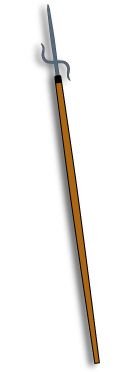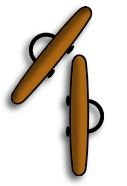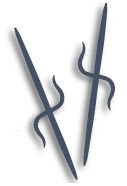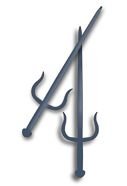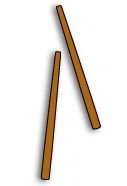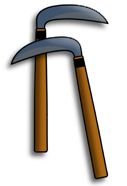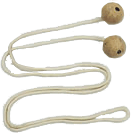R
You are using an out of date browser. It may not display this or other websites correctly.
You should upgrade or use an alternative browser.
You should upgrade or use an alternative browser.
What Kobudo Weapon you like most
- Thread starter TallAdam85
- Start date
R
RyuShiKan
Guest
R
RyuShiKan
Guest
R
RyuShiKan
Guest
R
RyuShiKan
Guest
R
RyuShiKan
Guest
R
RyuShiKan
Guest
S
shoshiman
Guest
HI everyone,
My favourite weapon is the one I am most frightened with as well. It's the Kama with Strings attached to the ends. I guess this weapon just commands R-E-S-P-E-C-T from me. The Bo comes next and Sai and Tonfa comes in a tie for third.
Peace and Respect :asian:
Shoshiman
My favourite weapon is the one I am most frightened with as well. It's the Kama with Strings attached to the ends. I guess this weapon just commands R-E-S-P-E-C-T from me. The Bo comes next and Sai and Tonfa comes in a tie for third.
Peace and Respect :asian:
Shoshiman
R
RyuShiKan
Guest
This is a partial list of the Kobudo Kata we practice:
Bo Kata
1Kihon (Basic)
2Sakugawa no Kun
3Sakugawa Nidansuku
4Sakugawa Sandansaku
5Sugi no Kun
6Tsukumino no Kun
Jo Kata
7Kihon (Basic)
8Tsukumino no Kun
9Sugi no Kun
10Sakugawa no Kun
11Sakugawa Nidansuku
12Sakugawa Sandansaku
Kama Kata
13Kihon (Basic)
14Kuzushi Sho
15Kuzushi Dai
Tan Bo Kata
16Kihon (Basic)
17Kuzushi Sho
18Kuzushi Dai
Nunchaku Kata
19Kihon (Basic)
20Jyu gata Nunchaku
Eku Kata
21Kihon Matsumura
22Matsumura Dai
Tonfa kata
23Kihon Sho
24Kihon Dai
25Kuzushi Sho
26Kuzushi Dai
Chinte Kata (weapon not empty hand)
27Kihon
28Chinte no Kata
Surichin Kata
29Kihon
30Surichin no Kata
Sai Kata
31Kihon
32Kunishi no Sai
33Uhugushiku no Sai
Manji Sai Kata
34Kihon
35Manji Sai no Kata
Chizi kun bo Kata
36Kihon
37Chizi kun bo no Kata
Nunte Bo Kata
38Kihon
39Matsumura Sho
40Matsumura Dai
(basically we do about 40 kobudo kata)
Bo Kata
1Kihon (Basic)
2Sakugawa no Kun
3Sakugawa Nidansuku
4Sakugawa Sandansaku
5Sugi no Kun
6Tsukumino no Kun
Jo Kata
7Kihon (Basic)
8Tsukumino no Kun
9Sugi no Kun
10Sakugawa no Kun
11Sakugawa Nidansuku
12Sakugawa Sandansaku
Kama Kata
13Kihon (Basic)
14Kuzushi Sho
15Kuzushi Dai
Tan Bo Kata
16Kihon (Basic)
17Kuzushi Sho
18Kuzushi Dai
Nunchaku Kata
19Kihon (Basic)
20Jyu gata Nunchaku
Eku Kata
21Kihon Matsumura
22Matsumura Dai
Tonfa kata
23Kihon Sho
24Kihon Dai
25Kuzushi Sho
26Kuzushi Dai
Chinte Kata (weapon not empty hand)
27Kihon
28Chinte no Kata
Surichin Kata
29Kihon
30Surichin no Kata
Sai Kata
31Kihon
32Kunishi no Sai
33Uhugushiku no Sai
Manji Sai Kata
34Kihon
35Manji Sai no Kata
Chizi kun bo Kata
36Kihon
37Chizi kun bo no Kata
Nunte Bo Kata
38Kihon
39Matsumura Sho
40Matsumura Dai
(basically we do about 40 kobudo kata)
C
chufeng
Guest
RSK,
Thanks!
Of those listed, the Chizi kun bo are my favorite...but I have no kata for them, per se...Maybe you can share that with Yiliquan1 on his next visit to Japan.
:asian:
chufeng
Thanks!
Of those listed, the Chizi kun bo are my favorite...but I have no kata for them, per se...Maybe you can share that with Yiliquan1 on his next visit to Japan.
:asian:
chufeng
Forty! How many empty-hand kata do you have on top of that?
What are the typical lengths of the tanbo and surunchin?
I usually think of the Jo as Japanese rather than Okinawan and would use something like yonshakubo for a four-foot Okinawan weapon. Is this Okinawan Jo, or Japanese Jo that's been adopted into your system?
What are the typical lengths of the tanbo and surunchin?
I usually think of the Jo as Japanese rather than Okinawan and would use something like yonshakubo for a four-foot Okinawan weapon. Is this Okinawan Jo, or Japanese Jo that's been adopted into your system?
R
RyuShiKan
Guest
Originally posted by arnisador
Forty! How many empty-hand kata do you have on top of that?
14 empty hand kata on top of the kobudo.
Naihanchi Shodan
Naihanchi Nidan
Naihanchi Sandan
Tomari Seisan
Pian Shodan
Pian Nidan
Pian Sandan
Pian Yondan
Pian Godan
Passai
Kusanku
Niseshi
Shiho Hapo No Te
Shiho Hapo Miyo No Te
Originally posted by arnisador
What are the typical lengths of the tanbo and surunchin?
The Tanbo are usually about 2 ½ feet long and the surichin is a six foot rope or chain with weighted ends.
Originally posted by arnisador
I usually think of the Jo as Japanese rather than Okinawan and would use something like yonshakubo for a four-foot Okinawan weapon. Is this Okinawan Jo, or Japanese Jo that's been adopted into your system?
The Jo/Bo can be found in many fighting systems through out the world and is by no means strictly a Japanese weapon. The Jo we use is about 48 to 50 inches in length and tapering like a bo. Sometimes a Jo has a reverse taper, being larger at both ends. The Jo is normally manipulated with both hands; however, it is sometimes used with one hand.
Thanks! With the jo, I meant to say that I associate the term jo with Japanese systems, whereas I associate the term bo with both Japanese and Okinawan systems. So I guess my real question is: Was the word 'jo' used in Okinawa too?
I think I recognize all the empty-hand kata, save these two:
Shiho Hapo No Te
Shiho Hapo Miyo No Te
My "karate Japanese" gets shiho as Four-step (or four-direction) and "no te" as "with hands" but that's it. Am I failing to recognize them or are these less common forms?
I think I recognize all the empty-hand kata, save these two:
Shiho Hapo No Te
Shiho Hapo Miyo No Te
My "karate Japanese" gets shiho as Four-step (or four-direction) and "no te" as "with hands" but that's it. Am I failing to recognize them or are these less common forms?
R
RyuShiKan
Guest
Originally posted by arnisador
Thanks! With the jo, I meant to say that I associate the term jo with Japanese systems, whereas I associate the term bo with both Japanese and Okinawan systems. So I guess my real question is: Was the word 'jo' used in Okinawa too?
There are many Okinawan styles that use the Jo and yes they use the word Jo in Okinawa.
Originally posted by arnisador
I think I recognize all the empty-hand kata, save these two:
Shiho Hapo No Te
Shiho Hapo Miyo No Te
These two kata are very rare and were taught by Mr. Wakinaguri who was a descendent of the "36 Chinese families" that were sent to Okinawa from China as envoys. He taught Taika Oyata theory about the body and how to study and develop technique. He was an expert in the art of kyusho jutsu.
Originally posted by arnisador
My "karate Japanese" gets shiho as Four-step (or four-direction) and "no te" as "with hands" but that's it. Am I failing to recognize them or are these less common forms?
The name doesnt translate as 4 steps or 4 directions. I wont go into the meaning of the names in public.........sorry long story.
Suffice it to say they have a more complex deeper meaning and much of my teachers fighting theory and application comes from these kata.
Interesting stuff. I don't know that I'd have the capacity to memorize 50-some forms!
S
Shuri-te
Guest
For weapons, I like Sai the best. I find they most closely mimic empty hand, and with the weight, I feel like I am developing my upper body further.
But the aspect of kobudo I really like is using empty hand techniques against the bo. Empty hand kata are filled with bo disarming techniques that are really fascinating to me.
But the aspect of kobudo I really like is using empty hand techniques against the bo. Empty hand kata are filled with bo disarming techniques that are really fascinating to me.
TallAdam85
3rd Black Belt
- Thread Starter
- #37
glad to see how many replys i got on this.
Hope i get more
Hope i get more
P
progressivetactics
Guest
adam, as you know I like the Modern arnis cane the best.....i thknk that is the most practical weapon out there... for traditional kobudo.....i have always been a fan of the kama......bo second.
TallAdam85
3rd Black Belt
- Thread Starter
- #39
good to see all these great replys:asian:
S
Shuri-te
Guest
Arnisador:
You seemed surprised at the 40 weapons kata practiced in a RyuTe dojo.
If you think that is alot, check out this system:
http://shidokan.dimentech.com/kata.html
There are 40 bo kata alone, not to mention about 20 sai kata and 10 tonfa kata, and it goes on from there.
I don't mean to imply any criticism at this approach, but I know that for me, trying to learn so many kata would merely mean that I would do them all badly, and would not be able to be effective at many of the movements.
You seemed surprised at the 40 weapons kata practiced in a RyuTe dojo.
If you think that is alot, check out this system:
http://shidokan.dimentech.com/kata.html
There are 40 bo kata alone, not to mention about 20 sai kata and 10 tonfa kata, and it goes on from there.
I don't mean to imply any criticism at this approach, but I know that for me, trying to learn so many kata would merely mean that I would do them all badly, and would not be able to be effective at many of the movements.

